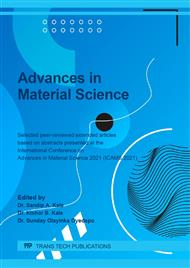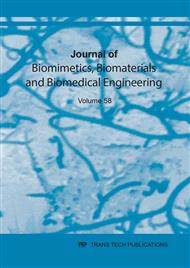[1]
D.S. Morais, R.M. Guedes, Antimicrobial Approaches for Textiles : From Research to Market, (2016) 1–21.
Google Scholar
[2]
Y. Gao, R. Cranston, Recent Advances in Antimicrobial Treatments of Textiles, Text. Res. J. 78 (2008) 60–72.
Google Scholar
[3]
M. Naebe, A.N.M.A. Haque, A. Haji, Plasma-assisted antimicrobial finishing of textiles: A review, Engineering. (2021).
Google Scholar
[4]
V. Bhandari, S. Jose, P. Badanayak, A. Sankaran, V. Anandan, Antimicrobial finishing of metals, metal oxides, and metal composites on textiles: a systematic review, Ind. Eng. Chem. Res. 61 (2022) 86–101.
DOI: 10.1021/acs.iecr.1c04203
Google Scholar
[5]
A. Reshma, V. Brindha Priyadarisini, Eco friendly antimicrobial finishing of textiles using bioactive metabolite from endophytic Streptomyces fradiae CQLW against bio deterioration, J. Text. Inst. 112 (2021) 902–913.
DOI: 10.1080/00405000.2020.1788750
Google Scholar
[6]
S.P. Deshmukh, S.M. Patil, S.B. Mullani, S.D. Delekar, Silver nanoparticles as an effective disinfectant: A review, Mater. Sci. Eng. C. 97 (2019) 954–965.
DOI: 10.1016/j.msec.2018.12.102
Google Scholar
[7]
S. Sütterlin, Aspects of bacterial resistance to silver, (2015).
Google Scholar
[8]
A. Panáček, L. Kvítek, M. Smékalová, R. Večeřová, M. Kolář, M. Röderová, F. Dyčka, M. Šebela, R. Prucek, O. Tomanec, Bacterial resistance to silver nanoparticles and how to overcome it, Nat. Nanotechnol. 13 (2018) 65.
DOI: 10.1038/s41565-017-0013-y
Google Scholar
[9]
J.L. Hobman, L.C. Crossman, Bacterial antimicrobial metal ion resistance, J. Med. Microbiol. 64 (2015) 471–497.
DOI: 10.1099/jmm.0.023036-0
Google Scholar
[10]
R. Singh, U.U. Shedbalkar, S.A. Wadhwani, B.A. Chopade, Bacteriagenic silver nanoparticles: synthesis, mechanism, and applications, Appl. Microbiol. Biotechnol. 99 (2015) 4579–4593.
DOI: 10.1007/s00253-015-6622-1
Google Scholar
[11]
S. Rwawiire, B. Tomkova, J. Militky, A. Jabbar, B.M. Kale, Development of a biocomposite based on green epoxy polymer and natural cellulose fabric (bark cloth) for automotive instrument panel applications, Compos. Part B Eng. 81 (2015) 149–157.
DOI: 10.1016/j.compositesb.2015.06.021
Google Scholar
[12]
S. Rwawiire, B. Tomkova, J. Militky, L. Hes, B.M. Kale, Acoustic and thermal properties of a cellulose nonwoven natural fabric (barkcloth), Appl. Acoust. 116 (2017) 177–183.
DOI: 10.1016/j.apacoust.2016.09.027
Google Scholar
[13]
S. Akbar, I. Tauseef, F. Subhan, N. Sultana, I. Khan, U. Ahmed, K.S. Haleem, An overview of the plant-mediated synthesis of zinc oxide nanoparticles and their antimicrobial potential, Inorg. Nano-Metal Chem. 50 (2020) 257–271.
DOI: 10.1080/24701556.2019.1711121
Google Scholar
[14]
A.M. Shehabeldine, A.H. Hashem, A.R. Wassel, M. Hasanin, Antimicrobial and antiviral activities of durable cotton fabrics treated with nanocomposite based on zinc oxide nanoparticles, acyclovir, nanochitosan, and clove oil, Appl. Biochem. Biotechnol. 194 (2022) 783–800.
DOI: 10.1007/s12010-021-03649-y
Google Scholar
[15]
E. Darvishi, D. Kahrizi, E. Arkan, Comparison of different properties of zinc oxide nanoparticles synthesized by the green (using Juglans regia L. leaf extract) and chemical methods, J. Mol. Liq. 286 (2019) 110831.
DOI: 10.1016/j.molliq.2019.04.108
Google Scholar
[16]
B. Madhukar, J. Wiener, J. Militky, S. Rwawiire, R. Mishra, K.I. Jacob, Y. Wang, Coating of cellulose-TiO 2 nanoparticles on cotton fabric for durable photocatalytic self-cleaning and stiffness, Carbohydr. Polym. 150 (2016) 107–113.
DOI: 10.1016/j.carbpol.2016.05.006
Google Scholar
[17]
P. Ganguly, C. Byrne, A. Breen, S.C. Pillai, Antimicrobial activity of photocatalysts: Fundamentals, mechanisms, kinetics and recent advances, Appl. Catal. B Environ. 225 (2018) 51–75.
DOI: 10.1016/j.apcatb.2017.11.018
Google Scholar
[18]
K. Hirota, M. Sugimoto, M. Kato, K. Tsukagoshi, T. Tanigawa, H. Sugimoto, Preparation of zinc oxide ceramics with a sustainable antibacterial activity under dark conditions, Ceram. Int. 36 (2010) 497–506.
DOI: 10.1016/j.ceramint.2009.09.026
Google Scholar



